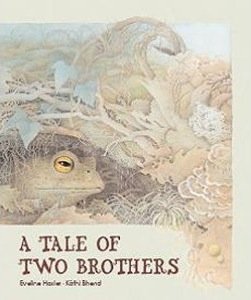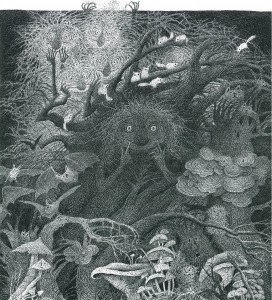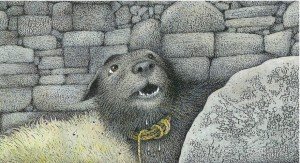 Two brothers, Morris and Boris, live together in an isolated valley with their chickens, cows and goats. At this point, the story could go in a number of directions, but The Tale of Two Brothers is a children’s book and not a headline in a newspaper. The story follows the usual fable-strewn path, with a fate-sealing quest, a charmed wood full of strange, watchful creatures, and of course, the moral, delivered upon the brothers in the form of fleshy retribution, or reward, depending on the situation. Each brother has a hump on his back, and are in all ways very similar, with one exception: Morris is kind and benevolent, and Boris is a bastard. I think you know where this is going…
Two brothers, Morris and Boris, live together in an isolated valley with their chickens, cows and goats. At this point, the story could go in a number of directions, but The Tale of Two Brothers is a children’s book and not a headline in a newspaper. The story follows the usual fable-strewn path, with a fate-sealing quest, a charmed wood full of strange, watchful creatures, and of course, the moral, delivered upon the brothers in the form of fleshy retribution, or reward, depending on the situation. Each brother has a hump on his back, and are in all ways very similar, with one exception: Morris is kind and benevolent, and Boris is a bastard. I think you know where this is going…
As Autumn settles in, the brothers must choose who will go up the mountain to perform some minor repairs on their hut before the snow flies. Morris (the good bro’) explains to Boris (the bad bro’) that as he was the one who went up in the spring, it is now Boris’s turn. Boris refuses, and rather than argue, Morris decides to do it himself. He sets out on his journey, and as one would expect of such an amiable hunchback, Morris is both mindful and fascinated by the alpine landscape and all the little feathered, furred, and occasionally slimy creatures he meets along the way. At one point, Morris bends down to get a closer look at a ‘moist, wart-covered frog’, noting it’s beautiful golden irises. (There is no mention of what the frog thought of Morris’s eyes.) Feeling the love, the forest offers up its bounty, and Morris is able to find enough water, and even a few chestnuts to roast over an open fire. Standing on the edge of a ravine, Morris shouts over the waterfall, “Beautiful Forest!” “Beautiful man-man-man-man,” answers the echo. I live near a ravine and I can tell you, it has never answered me back when I’ve expressed my appreciation. Perhaps it’s better that way.
Later that evening, Morris finds a cozy nook for the night, and while he’s sleeping, all the wood nymphs and
assorted sentient greenery conspire to give Morris ‘something that he will never forget.’ Hmmm. Interesting choice of words. The ‘something’ turns out to be a hump reduction, but in spite of a heightened awareness of everything around him, including the limpid eyes of bull frogs, Morris fails to notice his humplessness, thinking only that he had never felt so ‘light and free.’ As Morris whistles his way back down the mountain, Boris is the first to notice his brother’s altered state. He believes that if he retraces his brother’s steps, he too will be transformed. What follows is a one-man ecological disaster. He shouts at the toadstools (told you he was a bastard), dumps his scraps into the water, almost squashes the amber-eyed frog underfoot. At the ravine, he shouts, “What sorry old trees.” The echo answers, “What a sorry old man-man-man-man.”
And then the forest creatures give this contemptuous old hunchback something that he too will never forget: a hump enlargement, and adding insult to injury, a fresh dump of snow. Nasty.
Unlike most traditional fairy tales, especially those of the Grimm variety, the Tale of the Two Brothers ends with a sliver of insight on the part of the ‘bad’ brother. Upon the realization that his hump has only gotten humpier, Boris is overcome with sadness, but when he turns to his dog for solace, the dog ducks away fearfully, as if dodging a slap. Boris finally realizes the difference between his brother’s fate and his own lay ‘within himself’, and vows to take the trip again, but ‘now now. Not in the snow.’ That’s right Quasimodo, your festering soul can wait until spring.
The Tale of Two Brothers is a contemporary fable in the mold of something much older, something borne out of the black forests of Germany, or the mountain villages of Switzerland. The story, written by Eveline Hasler, is in fact based on a 150 year old Swiss folktale, though I could not find the original text. Hasler, an internationally acclaimed Swiss author, has done an excellent job retelling what is essentially a traditional quest story, where the journey up something, or through something, or across something reveals the true character of the hero. In this case, we know Morris is the good brother, the hero, and will be rewarded accordingly. We also know that a nasty fate will befall the ill-tempered Boris. What is particularly interesting about The Tale of Two Brothers, other than Boris’s weather-conditional change of heart, is the contemporary notions of reverence for nature, and for living in the moment. I kinda love that, and I kinda love the equally reverent illustrations by Kathi Bhend, a frequent collaborator with Eveline Hasler, and a fellow Swiss miss.
The exquisitely detailed pen & ink illustrations by Bhend are quite simply, beautiful. You have to take your time with this book. The typical black and white striations in birch trees transform into eyes, faces reveal themselves the edges along rocks and in the recesses of thick foliage. On several pages, Bhend uses washes of watercolour to add shimmering colour and depth to the drawings, beautifully realized in the golden iris of the frog, the sprays of autumn leaves blowing across the page, even in the rather fetching white-dotted, red-capped toadstools. (I am reminded of the art of Wayne Anderson in Bhend’s work. The two share an extraordinary ability to create fantastical worlds out of layers, many layers, of dots and lines.) Bhend’s love for the sensuous textures and curves of forest and mountain, and all the beasties, humped or otherwise, who dwell there, is present on every page. This is truly a case where the preoccupations of the author and the illustrator are a perfect match.
I have several other books by Kathi Bhend in my possession, including Henrietta and the Golden Eggs and the latest collaboration from Eveline Hasler and Kathi Bhend entitled In My Dreams I Can Fly. Both books are well worth seeking out, but for truly superior chicken art, I would recommend Henrietta.
I would also recommend being kind to toads, and whatever you do, don’t yell at the mushrooms.
A Tale of Two Brothers by Eveline Hasler, illustrations by Kathi Bhend. Published by NorthSouth Books, 2006 ISBN: 978-0735821026
In My Dreams I Can Fly by Eveline Hasler, illustrations by Kathi Bhend. Published by NorthSouth Books, 2008
Henrietta and the Golden Eggs by Hanna Johansen, illustrations by Kathi Bhend. Published by David R. Godine
*I will be reviewing the incredible work of Wayne Anderson in future blog posts.





